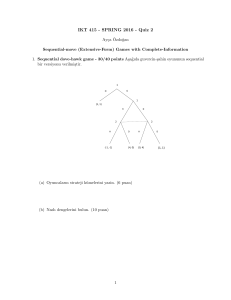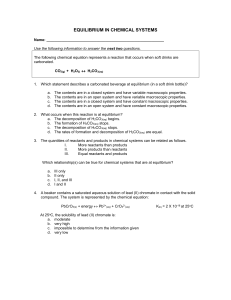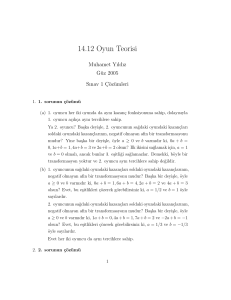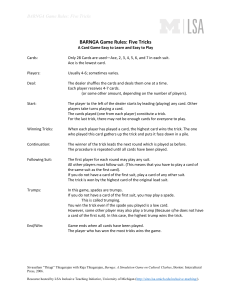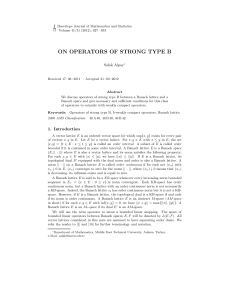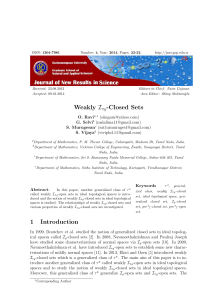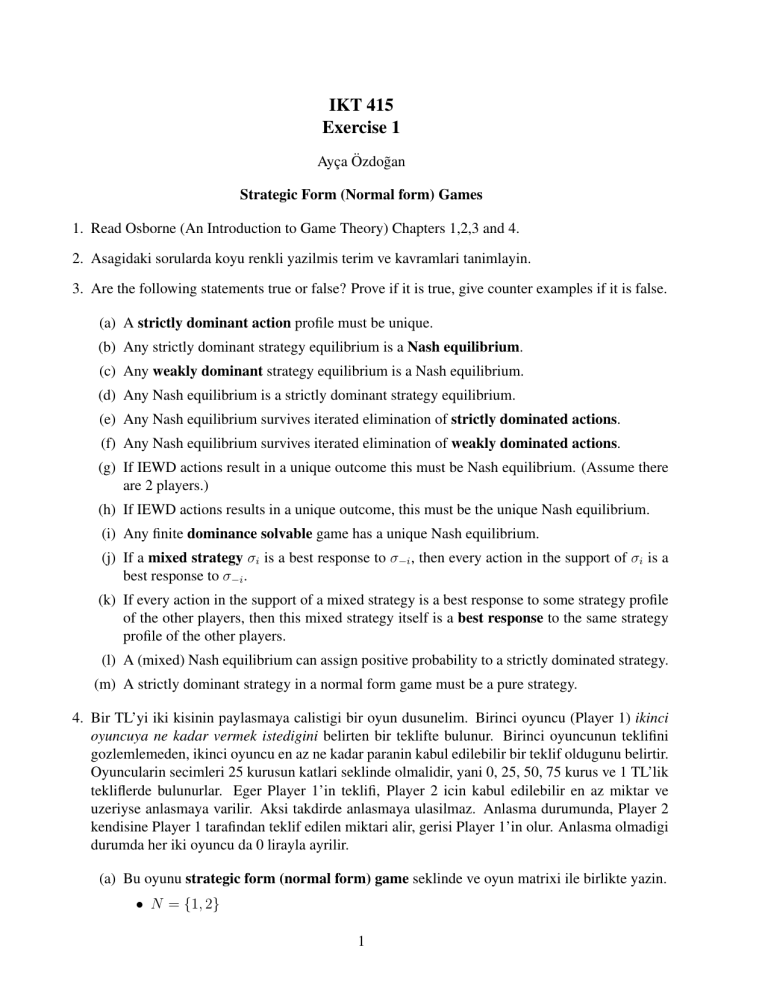
IKT 415
Exercise 1
Ayça Özdog̃an
Strategic Form (Normal form) Games
1. Read Osborne (An Introduction to Game Theory) Chapters 1,2,3 and 4.
2. Asagidaki sorularda koyu renkli yazilmis terim ve kavramlari tanimlayin.
3. Are the following statements true or false? Prove if it is true, give counter examples if it is false.
(a) A strictly dominant action profile must be unique.
(b) Any strictly dominant strategy equilibrium is a Nash equilibrium.
(c) Any weakly dominant strategy equilibrium is a Nash equilibrium.
(d) Any Nash equilibrium is a strictly dominant strategy equilibrium.
(e) Any Nash equilibrium survives iterated elimination of strictly dominated actions.
(f) Any Nash equilibrium survives iterated elimination of weakly dominated actions.
(g) If IEWD actions result in a unique outcome this must be Nash equilibrium. (Assume there
are 2 players.)
(h) If IEWD actions results in a unique outcome, this must be the unique Nash equilibrium.
(i) Any finite dominance solvable game has a unique Nash equilibrium.
(j) If a mixed strategy σi is a best response to σ−i , then every action in the support of σi is a
best response to σ−i .
(k) If every action in the support of a mixed strategy is a best response to some strategy profile
of the other players, then this mixed strategy itself is a best response to the same strategy
profile of the other players.
(l) A (mixed) Nash equilibrium can assign positive probability to a strictly dominated strategy.
(m) A strictly dominant strategy in a normal form game must be a pure strategy.
4. Bir TL’yi iki kisinin paylasmaya calistigi bir oyun dusunelim. Birinci oyuncu (Player 1) ikinci
oyuncuya ne kadar vermek istedigini belirten bir teklifte bulunur. Birinci oyuncunun teklifini
gozlemlemeden, ikinci oyuncu en az ne kadar paranin kabul edilebilir bir teklif oldugunu belirtir.
Oyuncularin secimleri 25 kurusun katlari seklinde olmalidir, yani 0, 25, 50, 75 kurus ve 1 TL’lik
tekliflerde bulunurlar. Eger Player 1’in teklifi, Player 2 icin kabul edilebilir en az miktar ve
uzeriyse anlasmaya varilir. Aksi takdirde anlasmaya ulasilmaz. Anlasma durumunda, Player 2
kendisine Player 1 tarafindan teklif edilen miktari alir, gerisi Player 1’in olur. Anlasma olmadigi
durumda her iki oyuncu da 0 lirayla ayrilir.
(a) Bu oyunu strategic form (normal form) game seklinde ve oyun matrixi ile birlikte yazin.
• N = {1, 2}
1
• Ai = {0, 25, 50, 75, 100}, i = 1, 2.
•
(
100 − a1 , if a1 ≥ a2
u1 (a1 , a2 ) =
0, otherwise
(
a1 , if a1 ≥ a2
u2 (a1 , a2 ) =
0, otherwise
Table 1: Payoff Matrix
0
25
50
75
100
0
100, 0
75, 25
50, 50
25, 75
0, 100
25
50
75
0,0
0, 0
0,0
75,25 0, 0
0,0
50,50 50, 50
0,0
25,75 25, 75 25,75
0,100 0, 100 0,100
100
0, 0
0, 0
0, 0
0, 0
0, 100
(b) Strictly dominant strategy ve weakly dominant strategy (her iki oyuncu icin) var mi?
Varsa neler?
YOK.
(c) Strictly dominated strategy ve weakly dominated strategy’ler (her iki oyuncu icin) var
mi? Varsa neler?
Player 1: No strictly dominated strategy; 100 is weakly dominated by 75.
Player 2: No strictly dominated strategy; 50, 75 and 1 are weakly dominated (by both 0 and
25).
(d) IESD actions ve IEWD actions sonucu kalan strategy kumesi nedir?
IESD action sonucu kalan strateji kumesi butun strateji profil kumesi, yani A1 × A2 .
IEWD action sonucu kalan strateji kumesi {0, 25} for player 1 and {0, 25} for player 2
(kalan strategy profil kumesi {0, 25} × {0, 25}).
(e) Nash dengelerini bulun.
N E(G) = {(0, 0), (25, 25), (50, 50), (75, 75), (100, 100)}.
(f) Do all Nash equilibria survive IESD actions and IEWD actions?
All NE survive IESD actions. Only (0, 0) and (25, 25) survive IEWD actions.
5. Two people are engaged in a joint project. If each person i puts in the effort xi (xi ∈ [0, 1]), which
costs her c(xi ); then the outcome of the project is worth f (x1 , x2 ). The worth of the project is
split evenly between two people regardless of their effort levels.
2
(a) Formulate this situation as a strategic game.
N = {1, 2}, A1 = A2 = [0, 1],
1
u1 (x1 , x2 ) = f (x1 , x2 ) − c(x1 )
2
1
u2 (x1 , x2 ) = f (x1 , x2 ) − c(x2 )
2
(b) Find and draw best responses for each player, and find Nash equilibria when,
i. f (x1 , x2 ) = 3x1 x2 , and ci (xi ) = x2i for i = 1, 2.
First, we derive the best response function for player 1 given player 2’s strategy. By
definition, player 1 will find the optimal strategy for himself given player 2’s strategy:
3
max u1 (x1 , x2 ) = x1 x2 − x21
2
x1 ∈A1
FOC gives us
3
x1 = BR1 (x2 ) = x2 .
4
(1)
Similarly,
3
x2 = BR2 (x1 ) = x1 .
(2)
4
Since Nash equilibrium (x∗1 , x∗2 ) is defined to be x∗i ∈ BRi (x∗−i ), (x∗1 , x∗2 ) should solve
(1) and (2). So, (x∗1 , x∗2 ) = (0, 0). The payoffs from NE are ui (0, 0) = 0 for both
players.
This question is related to the private provision of public goods problem and shows that
public goods tend to be underprovided.
X_2
BR_1
BR_2
X_2
ii. f (x1 , x2 ) = 4x1 x2 , and ci (xi ) = xi for i = 1, 2.
3
Now, the payoffs of players are u1 (x1 , x2 ) = 21 4x1 x2 − x1 and u2 (x1 , x2 ) = 21 4x1 x2 −
x2 . Let’s find the best response for player 1.
max u1 (x1 , x2 ) = 2x1 x2 − x1 = (2x2 − 1)x1
x1 ∈[0,1]
Since the payoff is linear in x1 , we cannot use the first order approach. However, the
set of actions is a closed interval and depending on the slope of the linear function, we
can pick the end points. For x2 > 12 , then the slope is strictly positive and the value
of the function is maximized at the highest possible value of x1 , which is 1. Thus,
x1 = BR1 (x2 ) = 1 for 12 < x2 ≤ 1. On the other hand, if x2 < 12 , then the slope is
negative and therefore the value of the function is maximized at the lowest value of x1 .
Thus, x1 = BR1 (x2 ) = 0 for 0 ≥ x2 < 21 . When x2 = 12 , player 1’s payoff is 0 no
matter what he does. So, BR1 (x2 ) = [0, 1] for x2 = 21 .
1
{1}, if 2 ≤ x2 ≤ 1
BR1 (x2 ) = [0, 1], if x2 = 12
{1}, if 0 ≤ x2 ≤ 21
and similarly,
1
{1}, if 2 ≤ x1 ≤ 1
BR2 (x1 ) = [0, 1], if x1 = 12
{1}, if 0 ≤ x1 ≤ 21
X_2
BR_2
BR_1
X_2
There are 3 Nash equilibria: (0, 0), ( 12 , 12 ), (1, 1). The payoffs from these equilibria are
ui (0, 0) = 0, ui ( 12 , 12 ) = 0, ui (1, 1) = 1 for i = 1, 2. If the other is non-cooperative,
then you are happier if you don’t cooperate. However, if the other cooperates, you want
to cooperate.
4
(c) In each case, is there a pair of effort levels that yields both players higher payoffs than the
Nash equilibrium effort levels?
(i) If both players put the maximum effort level (1,1) rather than (0,0), each would have
better payoffs ui (1, 1) = 21 .
(ii) In this multiple NE case, one NE namely (1,1) gives the highest payoffs to both players.
6. Two roommates are planning to clean their apartment on a Sunday. They each have an hour to
spend and they can spend it either by watching TV or by cleaning. If we denote the amount of
time contributed by person i by ci where ci ∈ [0, 1], that person spends her remaining time 1 − ci
by watching TV. Each person cares about both how clean the house is and the amount of time
they get to watch TV. Assume that the utility of each individual is given by
ui (c1 , c2 ) = bi ln(c1 + c2 ) + 1 − ci
where bi ln(c1 + c2 ) is the utility that individual i gets from clean house and (1 − ci ) represents
the utility of watching TV. One can interpret bi as the relative value to the individual i of having
a clean house.
(a) Write down the strategic form of this game.
N = {1, 2}, A1 = A2 = [0, 1],
u1 (c1 , c2 ) = b1 ln(c1 + c2 ) + 1 − c1
u2 (c1 , c2 ) = b2 ln(c1 + c2 ) + 1 − c2 .
(b) Find the Nash equilibria when (i) b1 > b2 and (ii) b1 = b2 .
We find the best response by maximizing each player’s utility taking the other player’s
strategy as given. This gives c1 = BR1 (c2 ) = b1 − c2 as long as b1 ≥ c2 and equals to 0
otherwise. Similarly, c2 = BR2 (c1 ) = b2 − c1 as long as b2 ≥ c1 and equals to 0 otherwise.
i. b1 > b2 :
c_2
b_1
BR_1
b_2
BR_2
c_1
b_2
b_1
5
The NE is at the intersection of these two best response curves, at (c∗1 , c∗2 ) = (b1 , 0).
The person who cares more does all the work in theory as well as in practice!!
ii. b1 = b2 .
c_2
b_1=
b_2
BR_1
BR_2
c_1
b_1=
b_2
In this case, every point in the line segment is a Nash equilibrium, i.e. the set of Nash
equilibria {(c1 , c2 ) : c1 + c2 = b1 , 0 ≤ ci ≤ 1 for i = 1, 2}.
7. Consider the Cournot dupoly game introduced in the class with linear demand P (Q) = a − Q,
where Q is the total quantity produced, i.e. Q = q1 + q2 . Each firm has constant marginal cost
ci , Ci (qi ) = ci qi , with a > c1 > c2 .
(a) Write down the strategic form of this game.
N = {1, 2}, qi ∈ Ai = [0, ∞) for i = 1, 2.
π1 (q1 , q2 ) = (a − q1 − q2 )q1 − c1 q1
π2 (q1 , q2 ) = (a − q1 − q2 )q2 − c2 q2
(b) Derive and draw the best responses for each firm. We find the best response by maximizing
each player’s utility taking the other player’s strategy as given.
max π1 (q1 , q2 ) = (a − q1 − q2 )q1 − c1 q1
q1
FOC gives
(
BR1 (q2 ) =
a−c1 −q2
,
2
if q2 ≤ a − c1
otherwise
0,
6
Similarly,
(
BR2 (q1 ) =
a−c2 −q1
,
2
if q1 ≤ a − c2
otherwise
0,
(c) Find Nash equilibrium. Which firm produces more in the Nash equilibrium.
This looks like
q_2
a –c_1
(a –c_2)/2
BR_2
BR_1
q_1
(a –c_1)/2
(a –c_2)/2
When we solve these two equations together (q1∗ , q2∗ ) = ( a−2c31 +c2 , a−2c32 +c1 ). Since c1 > c2 ,
q2∗ > q1∗ . More efficient firm produces more.
(d) What is the Nash equilibrium if 2c1 > a + c2 ?
2
This implies a−c
> a − c1 . The best responses look like
2
q_2
(a –c_2)/2
a –c_1
BR_2
BR_1
q_1
(a –c_1)/2
(a –c_2)/2
7
2
The best responses intersect at (q1∗ , q2∗ ) = (0, a−2c
).
2
8. Show or compute the followings for the first highest price auction. (You can assume there are
only two players.)
(a) Truthtelling, i.e. bi = vi is not a Nash equilibrium.
(b) Player 1 wins in all the Nash equilibria.
(c) b∗1 > b∗2 cannot happen in a Nash equilibrium.(Thus, b∗1 = b∗2 in every equilibrium.)
(d) Neither b1 ∗ < v2 nor b1 ∗ > v1 can hold. (Thus, in any Nash equilibrium of this game
v2 ≤ b∗1 = b∗2 ≤ v1 .)
(e) Find the set of Nash equilibria by drawing the best responses.
(f) Show that bidding anything strictly higher than v2 is weakly dominated for player 2. So
what is the undominated Nash equilibrium?
9. Show or compute the followings for the second highest price auction. (You can assume there are
only two players.)
(a) Truthtelling, i.e. bi = vi is a Nash equilibrium.
(b) Truthtelling, i.e. bi = vi weakly dominates all other bids for each player.
(c) bi = 0 for all i 6= n and bn > v1 is a Nash equilibrium. (Note that player n who value the
object the least gets the object!)
(d) (v2 , v1 , 0, 0.., 0) is a Nash equilibrium. (problematic!)
(e) Find the set of Nash equilibria by drawing the best responses.
10. Two bidders are involved in a first-price sealed bid auction where the value of the object is v > 0
for both of them. Bidders simultaneously submit a bid, which can be any nonnegative number,
and the highest bidder wins and pays her bid. In case of a tie, each bidder gets the object with an
equal probability. If bidder i bids bi and wins the object, then her payoff is v − bi , while is she
loses her payoff is 0.
(a) Assume v is common knowledge. Write down the payoffs and drive the best response
correspondence for each player.
(b) Find the Nash equilibria by finding the intersection of best responses.
11. Two animals are fighting over a prey. The prey is worth v to each player and the cost of fighting
is c1 for animal 1; and c2 or the second animal. If they both act aggressively (hawkish) and get
into a fight, they share the prey but suffer the cost of fighting. If they both act peacefully (dovish)
they share the prey without incurring the cost. If one acts hawkish and the other dovish, there is
no fight and hawkish gets all.
(a) Write down the strategic (normal) form of this game.
(b) Assume v, c1 , c2 are all nonnegative and find the Nash equilibria in each of the following
cases.
8
i. c1 > v2 , c2 > v2 .
ii. c1 > v2 , c2 < v2 .
12. Cournot competition: Consider the Cournot dupoly game with linear demand P (Q) = 250 − Q,
where Q is the total quantity produced, i.e. Q = q1 + q2 . Each firm has constant marginal cost
ci , Ci (qi ) = 10qi . Each firm simultaneously chooses a quantity level to produce.
P (Q) = 250−Q talep egrisi verilmis bir piyasada oynanan Cournot duopoly oyununu dusunelim.
Bu firmalarin marginal maliyetleri c1 = c2 = 10 olsun. Firmalar uretim miktarlarini simultane
sekilde secmekteler.
(a) Write down the strategic form of this game. Bu market oyununu normal form seklinde
yazin.
(b) Best response’lari cizerek Nash dengesini bulun.
(c) Firmalar Nash dengesindeki uretim miktarlarini sectiklerinde piyasadaki fiyat ne olur? Competitive equilibrium fiyatina (rekabetci piyasada olusacak fiyata) gore karsilastirin.
13. Two individuals can succeed in performing a job if and only if they both work. However, working
is costly since they need to exert effort; and the cost of effort is 0 < e < 1. If they both work and
succeed in the job, their payoff is 1 each. If an individual shirks, there is no cost of effort.
(a) Write the payoff matrix of this game.
(b) Find all the Nash equilibria (pure and mixed) of this game.
(c) How does the mixed strategy equilibrium change as e increases?
14. Bertrand competition
Suppose that there are two firms with unit costs c > 0. They choose prices for the same product
they produce. The one with the lower price captures the entire market. In case of a tie, they share
the market equally. The total market demand is equal to 1.
(a) Write down the strategic form of this game.
(b) Find Nash equilibrium.
9

